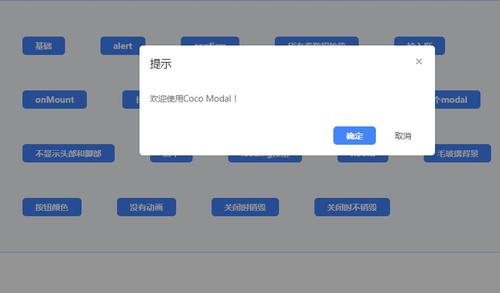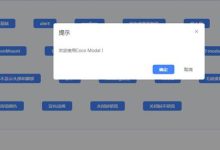在HTML5中,弹框(也称为对话框或弹出窗口)通常通过几种不同的方式实现,包括使用原生的浏览器功能、JavaScript库或者自定义的JavaScript代码,以下是一些常见的实现方法:,1、使用
alert(),
confirm(), 和
prompt() 函数,2、使用Bootstrap模态框(Modals),3、使用jQuery UI的Dialog,4、使用纯JavaScript和CSS创建自定义弹框,1. 使用
alert(),
confirm(), 和
prompt() 函数,这些是浏览器提供的基本弹框函数,不需要任何外部库或框架。,alert('文本内容'): 显示一个带有OK按钮的警告框。,confirm('文本内容'): 显示一个带有OK和Cancel按钮的确认框,返回一个布尔值。,prompt('文本内容', '默认值'): 显示一个可输入文本的提示框,返回用户输入的文本或null。,示例代码:,2. 使用Bootstrap模态框(Modals),Bootstrap是一个流行的前端开发框架,它提供了一套样式化的组件,包括用于创建弹框的模态框。,示例代码:,3. 使用jQuery UI的Dialog,如果你正在使用jQuery,那么可以使用jQuery UI库中的Dialog组件来创建更自定义的弹框。,示例代码:,4. 使用纯JavaScript和CSS创建自定义弹框,如果你想要完全控制弹框的外观和行为,你可以使用纯JavaScript和CSS创建自定义弹框,这需要编写更多的代码,但提供了最大的灵活性。,示例代码:,以上四种方法各有优缺点,选择哪一种取决于你的具体需求和项目环境,如果你的项目已经使用了Bootstrap或jQuery UI,那么使用它们提供的弹框组件会更简单快捷,如果你需要更高的自定义程度,那么最后一种方法可能是最佳选择。,
 ,<button onclick=”alert(‘这是一个警告!’);”>警告</button> <button onclick=”if (confirm(‘你确定吗?’)) alert(‘你点击了确定!’);”>确认</button> <button onclick=”var answer = prompt(‘你的名字是?’, ‘游客’); if (answer) alert(‘你好, ‘ + answer);”>提示</button>,<!引入Bootstrap CSS > <link rel=”stylesheet” href=”https://maxcdn.bootstrapcdn.com/bootstrap/4.5.2/css/bootstrap.min.css”> <!Button触发模态框 > <button type=”button” class=”btn btnprimary” datatoggle=”modal” datatarget=”#myModal”> 打开模态框 </button> <!模态框(Modal) > <div class=”modal fade” id=”myModal” tabindex=”1″ role=”dialog” arialabelledby=”exampleModalLabel” ariahidden=”true”> <div class=”modaldialog” role=”document”> <div class=”modalcontent”> <div class=”modalheader”> <h5 class=”modaltitle” id=”exampleModalLabel”>模态框标题</h5> <button type=”button” class=”close” datadismiss=”modal” arialabel=”Close”> <span ariahidden=”true”>×</span> </button> </div> <div class=”modalbody”> …这里可以放置内容… </div> <div class=”modalfooter”> <button type=”button” class=”btn btnsecondary” datadismiss=”modal”>关闭</button> <button type=”button” class=”btn btnprimary”>保存更改</button> </div> </div> </div> </div>,<!引入jQuery和jQuery UI的JS和CSS > <link rel=”stylesheet” href=”https://code.jquery.com/ui/1.12.1/themes/base/jqueryui.css”> <script src=”https://code.jquery.com/jquery3.6.0.min.js”></script> <script src=”https://code.jquery.com/ui/1.12.1/jqueryui.min.js”></script> <!一个简单的对话框 > <div id=”dialog” title=”基本对话框”> <p>这是一个简单的对话框。</p> </div> <!打开对话框的按钮 > <button id=”opendialog”>打开对话框</button> <script> $(function() { $(“#dialog”).dialog({ autoOpen: false }); // 初始化dialog,autoOpen设置为false表示不自动打开 $(“#opendialog”).on(“click”, function() { $(“#dialog”).dialog(“open”); // 点击按钮时打开dialog }); }); </script>,<!结构 > <div id=”custommodal” class=”modal”> <div class=”modalcontent”> <span class=”close”>×</span> <p>这是一个自定义的弹框!</p> </div> </div> <button id=”opencustommodal”>打开自定义弹框</button> <!样式 > <style> .modal { display: none; /* 默认隐藏 */ position: fixed; /* 位置固定 */ zindex: 1; /* 在页面顶部 */ left: 0; top: 0; width: 100%; /* 宽度全屏 */ height: 100%; /* 高度全屏 */ overflow: auto; /* 支持滚动 */ backgroundcolor: rgba(0,0,0,0.4); /* 背景颜色,半透明黑色 */ } .modalcontent { backgroundcolor: #fefefe; /* 弹框背景色 */ margin: 15% auto; /* 居中显示 */ padding: 20px; /* 内边距 */ border: 1px solid #888; /* 边框 */ width: 80%; /* 宽度 */ } .close { color: #aaa; /* 字体颜色 */ float: right; /* 右浮动 */ fontsize: 28px; /* 字体大小 */ fontweight: bold; /* 字体粗细 */ } .close:hover, .close:focus { color: black; /* 鼠标悬停时的颜色 */ textdecoration: none; /* 去除下划线 */ cursor: pointer; /* 改变鼠标样式 */ } </style> <!脚本 > <script> var modal = document.getElementById(“custommodal”); //获取弹框元素 var btn = document.getElementById(“opencustommodal”); //获取打开弹框的按钮元素 var span = document.getElementsByClassName(“close”)[0]; //获取关闭按钮元素 // 当用户点击按钮时打开弹框 btn.onclick = function() { modal.style.display = “block”; } // 当用户点击关闭按钮时关闭弹框 span.onclick = function() { modal.style.display = “none”; } // 当用户点击弹框以外的区域时,关闭弹框 window.onclick = function(event) { if (event.target == modal) { modal.style.display = “none”; } } </script>,
,<button onclick=”alert(‘这是一个警告!’);”>警告</button> <button onclick=”if (confirm(‘你确定吗?’)) alert(‘你点击了确定!’);”>确认</button> <button onclick=”var answer = prompt(‘你的名字是?’, ‘游客’); if (answer) alert(‘你好, ‘ + answer);”>提示</button>,<!引入Bootstrap CSS > <link rel=”stylesheet” href=”https://maxcdn.bootstrapcdn.com/bootstrap/4.5.2/css/bootstrap.min.css”> <!Button触发模态框 > <button type=”button” class=”btn btnprimary” datatoggle=”modal” datatarget=”#myModal”> 打开模态框 </button> <!模态框(Modal) > <div class=”modal fade” id=”myModal” tabindex=”1″ role=”dialog” arialabelledby=”exampleModalLabel” ariahidden=”true”> <div class=”modaldialog” role=”document”> <div class=”modalcontent”> <div class=”modalheader”> <h5 class=”modaltitle” id=”exampleModalLabel”>模态框标题</h5> <button type=”button” class=”close” datadismiss=”modal” arialabel=”Close”> <span ariahidden=”true”>×</span> </button> </div> <div class=”modalbody”> …这里可以放置内容… </div> <div class=”modalfooter”> <button type=”button” class=”btn btnsecondary” datadismiss=”modal”>关闭</button> <button type=”button” class=”btn btnprimary”>保存更改</button> </div> </div> </div> </div>,<!引入jQuery和jQuery UI的JS和CSS > <link rel=”stylesheet” href=”https://code.jquery.com/ui/1.12.1/themes/base/jqueryui.css”> <script src=”https://code.jquery.com/jquery3.6.0.min.js”></script> <script src=”https://code.jquery.com/ui/1.12.1/jqueryui.min.js”></script> <!一个简单的对话框 > <div id=”dialog” title=”基本对话框”> <p>这是一个简单的对话框。</p> </div> <!打开对话框的按钮 > <button id=”opendialog”>打开对话框</button> <script> $(function() { $(“#dialog”).dialog({ autoOpen: false }); // 初始化dialog,autoOpen设置为false表示不自动打开 $(“#opendialog”).on(“click”, function() { $(“#dialog”).dialog(“open”); // 点击按钮时打开dialog }); }); </script>,<!结构 > <div id=”custommodal” class=”modal”> <div class=”modalcontent”> <span class=”close”>×</span> <p>这是一个自定义的弹框!</p> </div> </div> <button id=”opencustommodal”>打开自定义弹框</button> <!样式 > <style> .modal { display: none; /* 默认隐藏 */ position: fixed; /* 位置固定 */ zindex: 1; /* 在页面顶部 */ left: 0; top: 0; width: 100%; /* 宽度全屏 */ height: 100%; /* 高度全屏 */ overflow: auto; /* 支持滚动 */ backgroundcolor: rgba(0,0,0,0.4); /* 背景颜色,半透明黑色 */ } .modalcontent { backgroundcolor: #fefefe; /* 弹框背景色 */ margin: 15% auto; /* 居中显示 */ padding: 20px; /* 内边距 */ border: 1px solid #888; /* 边框 */ width: 80%; /* 宽度 */ } .close { color: #aaa; /* 字体颜色 */ float: right; /* 右浮动 */ fontsize: 28px; /* 字体大小 */ fontweight: bold; /* 字体粗细 */ } .close:hover, .close:focus { color: black; /* 鼠标悬停时的颜色 */ textdecoration: none; /* 去除下划线 */ cursor: pointer; /* 改变鼠标样式 */ } </style> <!脚本 > <script> var modal = document.getElementById(“custommodal”); //获取弹框元素 var btn = document.getElementById(“opencustommodal”); //获取打开弹框的按钮元素 var span = document.getElementsByClassName(“close”)[0]; //获取关闭按钮元素 // 当用户点击按钮时打开弹框 btn.onclick = function() { modal.style.display = “block”; } // 当用户点击关闭按钮时关闭弹框 span.onclick = function() { modal.style.display = “none”; } // 当用户点击弹框以外的区域时,关闭弹框 window.onclick = function(event) { if (event.target == modal) { modal.style.display = “none”; } } </script>,
html5中的弹框如何实现
版权声明:本文采用知识共享 署名4.0国际许可协议 [BY-NC-SA] 进行授权
文章名称:《html5中的弹框如何实现》
文章链接:https://zhuji.vsping.com/464750.html
本站资源仅供个人学习交流,请于下载后24小时内删除,不允许用于商业用途,否则法律问题自行承担。
文章名称:《html5中的弹框如何实现》
文章链接:https://zhuji.vsping.com/464750.html
本站资源仅供个人学习交流,请于下载后24小时内删除,不允许用于商业用途,否则法律问题自行承担。

 国外主机测评 - 国外VPS,国外服务器,国外云服务器,测评及优惠码
国外主机测评 - 国外VPS,国外服务器,国外云服务器,测评及优惠码















